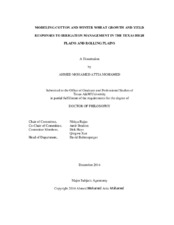| dc.description.abstract | A significant portion of the intensively cultivated agricultural areas in the U.S. is located in the Texas High Plains and Rolling Plains. In recent years, decreasing ground water supplies and precipitation variability are presenting challenges for profitable cotton (Gossypium hirsutum L.) and wheat (Triticum aestivum L.) production in these regions. A field study was conducted in 2012 and 2013 at Chillicothe, TX, to investigate the growth, yield, and water use efficiency (WUE) responses of cotton cultivars under different irrigation and tillage treatments. Results revealed that deficit irrigation of 45% of cotton evapotranspiration (ET) increased the dryland yield and WUE by 260% and 39%, respectively. The irrigation-by-variety interaction showed that the 90% ET replacement treatment involving PHY375 produced the greatest lint yield and WUE. Tillage did not significantly affect lint yield, WUE, and fiber quality. Increasing irrigation resulted in a linear increase in fiber length and strength, and a linear decrease in fiber micronaire. Two vegetation indices, Normalized Difference Vegetation Index (NDVI) and Normalized Difference Water Index (NDWI) were calculated using spectral reflectance dat. During the peak growing season, NDWI performed better compared to NDVI as no saturation problems were observed. The Crop Water Stress Index (CWSI) calculated using canopy and air temperature measurements showed significant differences among irrigation treatments. It was also observed that the CWSI and NDWI were negatively correlated. A modeling study was performed using the cotton growth simulation model, Cotton2K, to investigate the lint yield, WUE, and economic return responses using 31 years weather records (1980 – 2010) from the Texas Rolling Plains. Results revealed that replacing 112% ET maximized the yield while economic return was maximized at 108% ET. When water resources are limited, deficit irrigation at 80% ET replacement can be used to improve cotton WUE without significant yield and economic reductions in the semi-arid Texas Rolling Plains. A third study was performed on winter wheat using the DSSAT-CERES-Wheat model to investigate winter wheat growth and yield responses to irrigation management in the Texas High Plains using long-term weather datasets available for the Texas High Plains region (1980-2012). Results of winter wheat response to irrigation indicated that deficit irrigation between jointing and anthesis could significantly increase winter wheat grain yield and WUE. Application of 100 mm of irrigation at jointing and 120 mm at anthesis was found to produce a grain and biomass yields and WUE similar to full irrigation with significant amount of water saving. | en |


